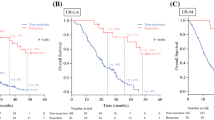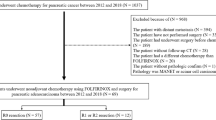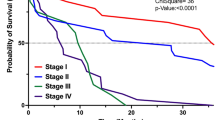Abstract
Purpose
We aimed to evaluate the predictive factors of conversion surgery in pancreatic adenocarcinoma (PAC) after neoadjuvant or palliative FOLFIRINOX using baseline and follow-up CT.
Methods
We retrospectively included 189 patients who had undergone more than 4 cycles of FOLFIRINOX. We reviewed baseline CT (B-CT), 1st follow-up CT (1st-CT), and the preoperative or last follow-up CT (L-CT) and determined tumor size changes according to the Response Evaluation Criteria in Solid Tumors (RECIST 1.1). Extra-pancreatic perineural invasion (EPNI) and resectability using NCCN 2019 guideline were evaluated. Subgroup analysis by baseline resectability was performed.
Results
B-CT included resectable (n = 25, 23.2%), borderline (n = 55, 29.1%), locally advanced (n = 44, 23.3%), and metastatic (n = 65, 34.4%) PAC. Seventy-four patients had undergone surgery (39.2%) with an 83.8% (62/74) R0 resection. For operability, resectable status at L-CT (hazard ratio (HR) 65.5; 95% confidence interval (CI) 5.0–865; P = 0.002), RECIST (partial response) at 1st-CT (HR 3.6; 95% CI 1.1–11.7; P = 0.032), and baseline borderline resectability (HR 8.6; 95% CI 1.6–46.4; P = 0.013) were important predictors. Based on a size reduction cut-off of 22.2%, the area under the receiver operating characteristic (ROC) curve (Az) was 0.761 (sensitivity = 70.3%, specificity = 74.8%). In subgroup analysis, RECIST (partial response) at 1st-CT was a significant predictor of locally advanced PAC (HR 32; 95% CI 4.5–227, P 0.001), and the optimal cut-off was 22.2% (Az = 0.914; sensitivity = 100%, specificity = 75%). Baseline tumor size (\(>\) 4 cm) (HR 5.6, 95% CI 1.3–24.3, P = 0.022) and unresectable status at 1st-CT (HR 4.8, 95% CI 1.1–20.6, P = 0.035) were significantly associated with margin-positive resection.
Conclusion
Both baseline and follow-up CT findings are useful to predict conversion surgery for PAC after FOLFIRINOX.




Similar content being viewed by others
Availability of data and materials
We declared that materials described in the manuscript, including all relevant raw data, will be freely available to any scientist wishing to use them for non-commercial purposes, without breaching participant confidentiality.
Code availability
All softwares used during the study appear in the submitted article; No code was generated or used during the study.
Abbreviations
- PAC:
-
Pancreatic adenocarcinoma
- FOLFIRINOX:
-
5-Fluorouracil/leucovorin/irinotecan/oxaliplatin
- RECIST:
-
Response evaluation criteria in solid tumors
- EPNI:
-
Extra-pancreatic perineural invasion
- NCCN:
-
National Comprehensive Cancer Network
- ROC:
-
Receiver operating characteristic
References
Huang J, Lok V, Ngai CH et al (2021) Worldwide Burden of, Risk Factors for, and Trends in Pancreatic Cancer. Gastroenterology 160:744-754
Berger AC, Meszoely IM, Ross EA, Watson JC, Hoffman JP (2004) Undetectable preoperative levels of serum CA 19-9 correlate with improved survival for patients with resectable pancreatic adenocarcinoma. Ann Surg Oncol 11:644-649
White RR, Lowy AM (2017) Clinical Management: Resectable Disease. Cancer J 23:343-349
Gemenetzis G, Groot VP, Blair AB et al (2019) Survival in Locally Advanced Pancreatic Cancer After Neoadjuvant Therapy and Surgical Resection. Ann Surg 270:340-347
Satoi S, Yamaue H, Kato K et al (2013) Role of adjuvant surgery for patients with initially unresectable pancreatic cancer with a long-term favorable response to non-surgical anti-cancer treatments: results of a project study for pancreatic surgery by the Japanese Society of Hepato-Biliary-Pancreatic Surgery. J Hepatobiliary Pancreat Sci 20:590-600
Michelakos T, Pergolini I, Castillo CF et al (2019) Predictors of Resectability and Survival in Patients With Borderline and Locally Advanced Pancreatic Cancer who Underwent Neoadjuvant Treatment With FOLFIRINOX. Ann Surg 269:733-740
Dhir M, Malhotra GK, Sohal DPS et al (2017) Neoadjuvant treatment of pancreatic adenocarcinoma: a systematic review and meta-analysis of 5520 patients. World J Surg Oncol 15:183
Conroy T, Desseigne F, Ychou M et al (2011) FOLFIRINOX versus gemcitabine for metastatic pancreatic cancer. N Engl J Med 364:1817-1825
Von Hoff DD, Ervin T, Arena FP et al (2013) Increased survival in pancreatic cancer with nab-paclitaxel plus gemcitabine. N Engl J Med 369:1691-1703
Petrelli F, Coinu A, Borgonovo K et al (2015) FOLFIRINOX-based neoadjuvant therapy in borderline resectable or unresectable pancreatic cancer: a meta-analytical review of published studies. Pancreas 44:515-521
Yoshitomi H, Takano S, Furukawa K, Takayashiki T, Kuboki S, Ohtsuka M (2019) Conversion surgery for initially unresectable pancreatic cancer: current status and unresolved issues. Surg Today 49:894-906
Hank T, Strobel O (2019) Conversion Surgery for Advanced Pancreatic Cancer. J Clin Med 8:1945–1963
Yeh R, Dercle L, Garg I, Wang ZJ, Hough DM, Goenka AH (2018) The Role of 18F-FDG PET/CT and PET/MRI in Pancreatic Ductal Adenocarcinoma. Abdom Radiol (NY) 43:415-434
Chen BB, Tien YW, Chang MC et al (2018) Multiparametric PET/MR imaging biomarkers are associated with overall survival in patients with pancreatic cancer. Eur J Nucl Med Mol Imaging 45:1205-1217
Rhee H, Park M-S (2021) The Role of Imaging in Current Treatment Strategies for Pancreatic Adenocarcinoma. Korean J Radiol 22:23-40
Catalano C, Laghi A, Fraioli F et al (2003) Pancreatic carcinoma: the role of high-resolution multislice spiral CT in the diagnosis and assessment of resectability. Eur Radiol 13:149-156
Olivié D, Lepanto L, Billiard JS, Audet P, Lavallée JM (2007) Predicting resectability of pancreatic head cancer with multi-detector CT. Surgical and pathologic correlation. Jop 8:753-758
Kim YE, Park MS, Hong HS et al (2009) Effects of neoadjuvant combined chemotherapy and radiation therapy on the CT evaluation of resectability and staging in patients with pancreatic head cancer. Radiology 250:758-765
Morgan DE, Waggoner CN, Canon CL et al (2010) Resectability of pancreatic adenocarcinoma in patients with locally advanced disease downstaged by preoperative therapy: a challenge for MDCT. AJR Am J Roentgenol 194:615-622
Tempero MA, Malafa MP, Chiorean EG et al (2019) Pancreatic Adenocarcinoma, Version 1.2019. J Natl Compr Canc Netw 17:202-210
Eisenhauer EA, Therasse P, Bogaerts J et al (2009) New response evaluation criteria in solid tumours: revised RECIST guideline (version 1.1). Eur J Cancer 45:228-247
Chang ST, Jeffrey RB, Patel BN et al (2016) Preoperative Multidetector CT Diagnosis of Extrapancreatic Perineural or Duodenal Invasion Is Associated with Reduced Postoperative Survival after Pancreaticoduodenectomy for Pancreatic Adenocarcinoma: Preliminary Experience and Implications for Patient Care. Radiology 281:816-825
Byun Y, Han Y, Kang JS et al (2019) Role of surgical resection in the era of FOLFIRINOX for advanced pancreatic cancer. J Hepatobiliary Pancreat Sci 26:416-425
Al-Hawary MM, Francis IR, Chari ST et al (2014) Pancreatic Ductal Adenocarcinoma Radiology Reporting Template: Consensus Statement of the Society of Abdominal Radiology and the American Pancreatic Association. Radiology 270:248-260
Koo TK, Li MY (2016) A Guideline of Selecting and Reporting Intraclass Correlation Coefficients for Reliability Research. J Chiropr Med 15:155-163
Assifi MM, Lu X, Eibl G, Reber HA, Li G, Hines OJ (2011) Neoadjuvant therapy in pancreatic adenocarcinoma: a meta-analysis of phase II trials. Surgery 150:466-473
Janssen QP, Buettner S, Suker M et al (2019) Neoadjuvant FOLFIRINOX in Patients With Borderline Resectable Pancreatic Cancer: A Systematic Review and Patient-Level Meta-Analysis. J Natl Cancer Inst 111:782-794
Hackert T, Sachsenmaier M, Hinz U et al (2016) Locally Advanced Pancreatic Cancer: Neoadjuvant Therapy With Folfirinox Results in Resectability in 60% of the Patients. Ann Surg 264:457-463
Takahashi C, Shridhar R, Harris CL et al (2018) Adjuvant therapy for margin positive pancreatic cancer. Journal of Clinical Oncology 36:390-390
Katz MH, Fleming JB, Bhosale P et al (2012) Response of borderline resectable pancreatic cancer to neoadjuvant therapy is not reflected by radiographic indicators. Cancer 118:5749-5756
Wagner M, Antunes C, Pietrasz D et al (2017) CT evaluation after neoadjuvant FOLFIRINOX chemotherapy for borderline and locally advanced pancreatic adenocarcinoma. Eur Radiol 27:3104-3116
Chakraborty S, Singh S (2013) Surgical resection improves survival in pancreatic cancer patients without vascular invasion- a population based study. Ann Gastroenterol 26:346-352
Gharibi A, Adamian Y, Kelber JA (2016) Cellular and molecular aspects of pancreatic cancer. Acta Histochem 118:305-316
Hong SB, Lee SS, Kim JH et al (2018) Pancreatic Cancer CT: Prediction of Resectability according to NCCN Criteria. Radiology 289:710-718
Mochizuki K, Gabata T, Kozaka K et al (2010) MDCT findings of extrapancreatic nerve plexus invasion by pancreas head carcinoma: correlation with en bloc pathological specimens and diagnostic accuracy. Eur Radiol 20:1757-1767
Liebig C, Ayala G, Wilks JA, Berger DH, Albo D (2009) Perineural invasion in cancer: a review of the literature. Cancer 115:3379-3391
Windsor JA, Barreto SG (2017) The concept of 'borderline resectable' pancreatic cancer: limited foundations and limited future? J Gastrointest Oncol 8:189-193
Hopper KD, Kasales CJ, Eggli KD et al (1996) The impact of 2D versus 3D quantitation of tumor bulk determination on current methods of assessing response to treatment. J Comput Assist Tomogr 20:930-937
Feng M, Balter JM, Normolle D et al (2009) Characterization of pancreatic tumor motion using cine MRI: surrogates for tumor position should be used with caution. Int J Radiat Oncol Biol Phys 74:884-891
Funding
The authors did not receive support from any organization for the submitted work.
Author information
Authors and Affiliations
Contributions
Conceptualization, Methodology, Supervision, Writing—review & editing: JHK. Methodology, Formal analysis, Writing—original draft: S-JP. Conceptualization, Methodology, Data curation, Investigation, Writing–review: IJ and JKH.
Corresponding author
Ethics declarations
Conflict of interest
The authors have no relevant financial or non-financial interests to disclose.
Ethical approval
This study was approved by Institutional Review Board of Seoul National University Hospital ((IRB No. 2005-122-1124) and written informed consent was waived. This study was in accordance with the 1964 Helsinki Declaration and its later amendments or comparable ethical standards.
Informed consent
Written informed consent was waived by Institutional Review Board of Seoul National University Hospital due to retrospective design of the study.
Additional information
Publisher's Note
Springer Nature remains neutral with regard to jurisdictional claims in published maps and institutional affiliations.
Supplementary Information
Below is the link to the electronic supplementary material.
Rights and permissions
About this article
Cite this article
Park, SJ., Kim, J.H., Joo, I. et al. Predictors of conversion surgery in patients with pancreatic cancer who underwent neoadjuvant or palliative FOLFIRINOX treatment using baseline and follow-up CT. Abdom Radiol 46, 4765–4778 (2021). https://doi.org/10.1007/s00261-021-03127-3
Received:
Revised:
Accepted:
Published:
Issue Date:
DOI: https://doi.org/10.1007/s00261-021-03127-3




